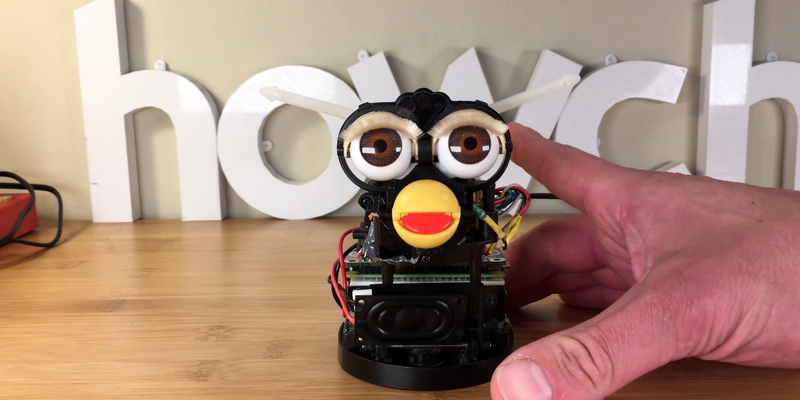[Zach Levine] wrote in to share a project just completed: a classic Furby packing a Raspberry Pi running Alexa: he calls it Furlexa.
The original Furby product wowed consumers of the 90s. In addition to animatronic movements, it also packed simulated voice learning technology that seemed to allow the Furby to learn to speak. It wasn’t like anything else on the market, and even got the toy banned from NSA’s facilities in case it could spy on them. Elegantly, the robot uses only one motor to move all of its parts, using a variety of plastic gears, levers, and cams to control all of the robot’s body parts and to make it dance.
Over the past twenty years the Furby has earned the reputation as one of the most hackable toys ever — despite its mystery microcontroller, which was sealed in plastic to keep the manufacturer’s IP secret. [Zach] replaced the control board with a Pi Zero. He also replaced the crappy mic and pizeo speaker that came with toy with a Pimoroni Speaker pHat and a better mic.
While classic Furbys have a reputation for hackability, the new ones aren’t immune: this Infiltrating Furby is based on a recent model of the toy.

















What would you call a Furby crossed with a Raspberry Pi?
a rasburby
He immolated a Furby!!!!
For SCIANCE!@
GAHHH Science :(
Here at HaD we do all our SCIANCE from scratch. No hand holding.
Cool project. Mine all have normal speakers in them.instead of piezo or “pizeo” as the case may be.
Now, wire it up to a Roomba and see what evil is unleashed!
Oh boy you could have Furboomba battles.
Add a flame throwers, knifes and a pellet gun.
And watch the Battles.
Or have it as a roaming guard that can come out from under the couch firing and shutting flames at your feet.
I’d worry that Jar Jar Binks would turn up to a Furboomba battle. Scary.
Why leave out Alexa in this, and make a Furbymon of some sort. “Furoombalexa, use ‘Flamethrower!'”. That’d be awesome.
“Over the past twenty years the Furby has earned the reputation as one of the most hackable toys ever — despite its mystery microcontroller, which was sealed in plastic to keep the manufacturer’s IP secret.”
Toy design must be one of those fields where an engineer can do some impressive stuff while acting like a big kid.
I’m fortunate enough to be able to tell you that, yes, yes it is!
Not so mysterious: https://www.electronicproducts.com/Digital_ICs/Microprocessors_Microcontrollers_DSPs/What_makes_a_Furby_tick_The_venerable_DSP.aspx
Pretty cool. but…
A battery for the motors AND an AC adapter for the Pi? That’s the worst of both worlds, tied to the wall AND a battery that needs replacement. Why not use a heftier AC adapter and run the motor off of that too?
I’m tellin’ ya man, put a camera on it (I’m sure there is some provision on the Alexa for one, Amazon just isn’t talking about it) and put it on a Roomba = evil spybot.
Just because I’m paranoid, doesn’t mean someone isn’t out to get me.
B^)
he’s nearly there. it is still missing the encoder input from the program drum so the motions actually make sense: looking, blinking, waving ears and of course speaking. or was there no encoder input and was it soly done with timing. turn motor in direction A for 2.6 seconds, reverse for 0,8 seconds, go forward again for 0.8 seconds. repeat that for speech etc.
iirc the program drum has different zones for different combination of motions.
Yea, the resemblence of a personality will really come when/if the motions are synced, one of the great strengths of the original. If it’s a some thing bugging for your attention, or some one, is a big difference.